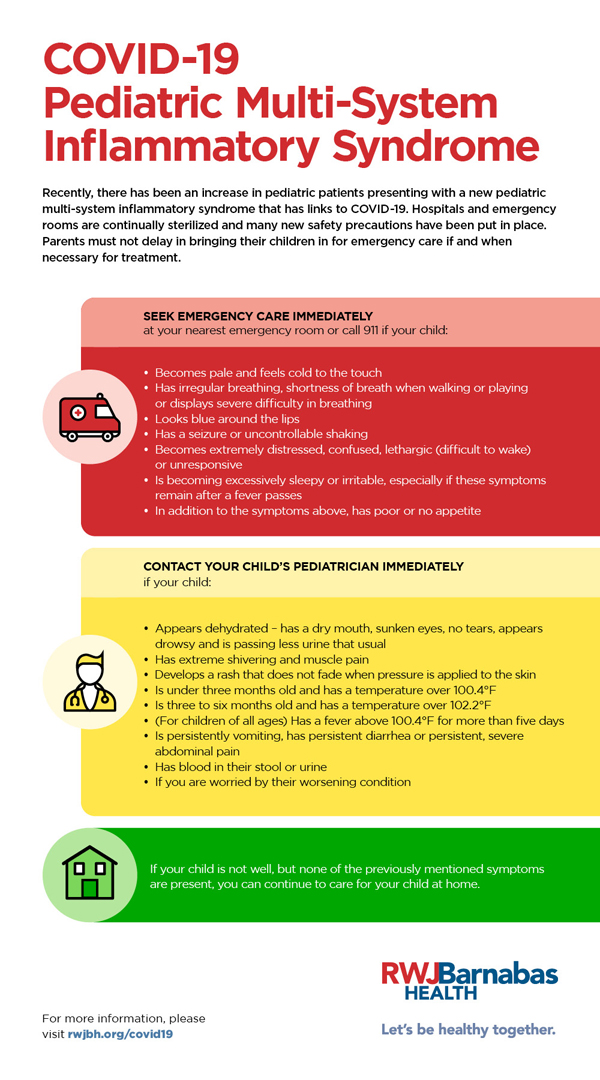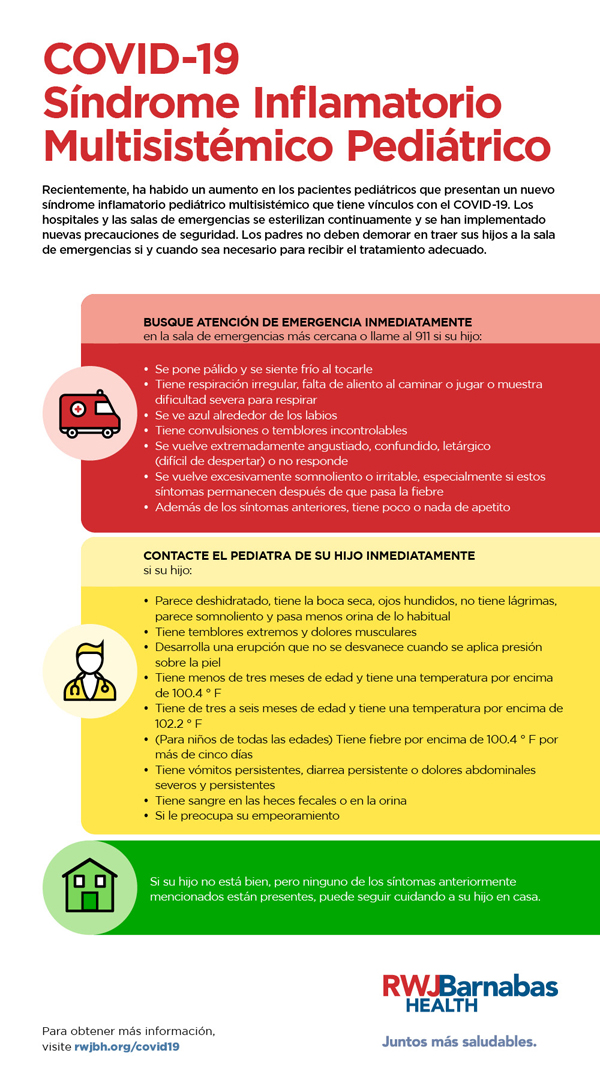Recently, there has been an increase in pediatric patients presenting with a new pediatric multi-system inflammatory syndrome that has links to COVID-19. Hospitals and emergency rooms are continually sterilized and many new safety precautions have been put in place. Parents must not delay in bringing their children in for emergency care if and when necessary for treatment.
SEEK EMERGENCY CARE IMMEDIATELY at your nearest emergency room or call 911 if your child:
- Becomes pale and feels cold to the touch
- Has irregular breathing, shortness of breath when walking or playing or displays severe difficulty in breathing
- Looks blue around the lips
- Has a seizure or uncontrollable shaking
- Becomes extremely distressed, confused, lethargic (difficult to wake) or unresponsive
- Is becoming excessively sleepy or irritable, especially if these symptoms remain after a fever passes
- In addition to the symptoms above, has poor or no appetite
CONTACT YOUR CHILD’S PEDIATRICIAN IMMEDIATELY if your child:
- Appears dehydrated – has a dry mouth, sunken eyes, no tears, appears drowsy and is passing less urine that usual
- Has extreme shivering and muscle pain
- Develops a rash that does not fade when pressure is applied to the skin
- Is under three months old and has a temperature over 100.4°F
- Is three to six months old and has a temperature over 102.2°F
- (For children of all ages) Has a fever above 100.4°F for more than five days
- Is persistently vomiting, has persistent diarrhea or persistent, severe abdominal pain
- Has blood in their stool or urine
- If you are worried by their worsening condition
If your child is not well, but none of the previously mentioned symptoms are present, you can continue to care for your child at home.
For more information, please visit rwjbh.org/covid19

COVID-19 Síndrome Inflamatorio Multisistémico Pediátrico
Recientemente, ha habido un aumento en los pacientes pediátricos que presentan un nuevo síndrome inflamatorio pediátrico multisistémico que tiene vínculos con el COVID-19. Los hospitales y las salas de emergencias se esterilizan continuamente y se han implementado nuevas precauciones de seguridad. Los padres no deben demorar en traer sus hijos a la sala de emergencias si y cuando sea necesario para recibir el tratamiento adecuado.
BUSQUE ATENCIÓN DE EMERGENCIA INMEDIATAMENTE en la sala de emergencias más cercana o llame al 911 si su hijo:
- Se pone pálido y se siente frío al tocarle
- Tiene respiración irregular, falta de aliento al caminar o jugar o muestra dificultad severa para respirar
- Se ve azul alrededor de los labios
- Tiene convulsiones o temblores incontrolables
- Se vuelve extremadamente angustiado, confundido, letárgico (difícil de despertar) o no responde
- Se vuelve excesivamente somnoliento o irritable, especialmente si estos síntomas permanecen después de que pasa la fiebre
- Además de los síntomas anteriores, tiene poco o nada de apetito
CONTACTE EL PEDIATRA DE SU HIJO INMEDIATAMENTE si su hijo:
- lágrimas, parece somnoliento y pasa menos orina de lo habitual
- Tiene temblores extremos y dolores musculares
- Desarrolla una erupción que no se desvanece cuando se aplica presión sobre la piel
- Tiene menos de tres meses de edad y tiene una temperatura por encima de 100.4 ° F
- Tiene de tres a seis meses de edad y tiene una temperatura por encima de 102.2 ° F
- (Para niños de todas las edades) Tiene fiebre por encima de 100.4 ° F por más de cinco días
- Tiene vómitos persistentes, diarrea persistente o dolores abdominales severos y persistentes
- Tiene sangre en las heces fecales o en la orina
- Si le preocupa su empeoramiento
Si su hijo no está bien, pero ninguno de los síntomas anteriormente mencionados están presentes, puede seguir cuidando a su hijo en casa.
Para obtener más información, visite rwjbh.org/covid19
